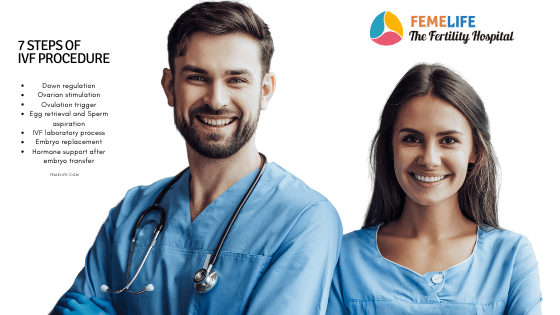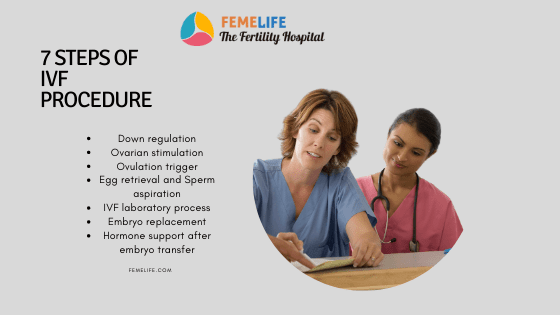
IVF procedure involves the fertilisation of eggs with sperm outside the body. It is advised to couples who fail to conceive naturally. Ideally couples should try for a year before starting any treatment. Natural conception may fail due to various reasons. If your fertility specialist doesn’t find any fault with you or your partner then, it may be unexplained infertility. You may have problems with growth or release of eggs. This usually is related to underneath hormone problems in your body. Consequently, it leads to infertility. Similarly, your partner may have problems with sperm production, maturation or release. As a result, you may need IVF treatment. Endometriosis, tubal disease, PCOS are among common causes of female infertility.
IVF may be advised to couples without a problem of conceiving. Among these causes are repeated miscarriages and couples requiring PGD. Patients undergoing cancer treatment or requiring egg freezing for fertility preservation may also opt for IVF procedure.
What is IVF procedure?
IVF procedure is a programme for 4 to 6 weeks which includes series of tests and medications. It includes injections consist of down regulating injections and stimulating hormones followed by supporting medications and shots. IVF duration depends on the protocol followed which is decides by the fertility specialist. Both protocols are followed by supporting hormone medications or injections for 15 days till the result comes.
What is the Difference between IUI and IVF procedure?
IUI a fertility treatment where sperm is processed and inserted directly into a woman’s uterus. This reduces the time travel for the sperm to the egg during ovulation. The fertilisation happens naturally in IUI whereas in IVF procedure fertilisation is assisted by laboratory process.
What is pre-treatment IVF procedure?
Before IVF treatment certain steps are followed to improve response of hormones and to reduce complications. These pre-treatment process minimises risk of cyst formation and yields healthy eggs for IVF procedure.
Seven steps of IVF procedure
- Down regulation
- Ovarian stimulation
- Ovulation trigger
- Egg retrieval and Sperm aspiration
- IVF laboratory process
- Embryo replacement
- Hormone support after embryo transfer
Down regulation before IVF procedure
This is a procedure by which pituitary gland is stopped from controlling the ovary. As a result, it reduces the risk of a cycle being cancelled by luteinising hormone (LH) hormone. LH hormone can disrupt normal follicle and oocyte development. Moreover, it can stimulate premature release of the eggs before they can be collected in the laboratory.
Ovarian stimulation
This aims at producing a number of mature eggs which can be collected for fertilisation in the laboratory. It is done by giving daily injections for 10- 12 days. Hormones like FSH and LH are given as shots in various combinations. The dose and duration is decided by ultrasound and hormone monitoring of cycle.
Ovulation trigger in IVF procedure
After the growth of follicles, at the end of the stimulation phase maturation of eggs is important. In an IVF cycle, eggs are collected after the ovulation trigger. HCG is an hormone which is used to mimic the natural endogenous LH surge. As a result, the process of ovulation id initiated. Then, mature eggs are collected from the woman and fertilised with sperm in a laboratory.
Oocyte and sperm retrieval
After triggering, mature oocytes are aspirated from the woman’s ovaries for fertilisation in the laboratory. Egg harvesting can either be done under direct vision laparoscopically or by ultrasound. Since, transvaginal oocyte retrieval is unpleasant and painful effective anaesthesia or analgesia is provided to minimise adverse effects.
In addition, in some cases of male factor infertility the sperm has to be obtained directly from the testes. Surgically collected sperm in azoospermia are immature. Hence, have low fertilising ability with standard IVF. It is therefore necessary to use ICSI.
IVF laboratory process
In vitro fertilisation (IVF) is a complex series of procedures used to achieve fertilisation. IVF or ICSI is the most effective form of assisted reproductive technology. IVF/ICSI aims at achieving fertilisation and embryo development through hi-tech laboratory equipment and skilful techniques. In IVF, the eggs are mixed with partner’s sperm in a dish to achieve fertilisation. ICSI is an advanced procedure where a sperm is injected into an egg through an inverted microscope with manipulator. ICSI achieves higher fertilisation than IVF procedure.
Embryo culture and replacement
IVF aims for a woman to have a healthy baby delivered safely at term with minimum risks. However, this procedure is associated with a risk of multiple pregnancy and harm for both mother and babies. After IVF procedure embryos are cultured in the laboratory for optimal growth. Once the embryos are ready patients return to the IVF facility for embryo transfer. Embryo transfer is a quicker and easier procedure than retrieval of eggs. The doctor inserts a flexible thin catheter into the uterus through which embryos are deposited.
Hormone support after embryo transfer
In a normal menstrual cycle, once ovulation has occurred, the endometrium prepares to receive a fertilised embryo. However, during IVF procedure use of hormones to block the activity of the pituitary gland can result in inadequate production of support hormones. Hence, in IVF the luteal phase needs to be supported by means of progesterone, human chorionic gonadotropin (hCG) and other medication. Luteal phase support with progesterone is associated with significantly more live full-term singleton births.
How long does IVF process take?
IVF treatment is a programed process and usually take 4 to 6 weeks to complete. Before starting IVF, procedure couple are investigated for any medical or surgical disorders. Their fertility efficiency is also evaluated through series of tests. This usually takes 2 to 3 weeks. IVF protocol is designed as per these reports. IVF programme can be through a long or short protocol. Long protocol takes 4 weeks whereas short protocol can be finished in 2 weeks. After the procedure is over patients are put on few medications and rest till the pregnancy test. This is called luteal support for a period of 2 weeks.
Are IVF babies normal?
IVF is an assisted reproductive technology used for couples failed in natural conception. In this method fertilisation of egg and sperm is enhanced by technical methods done in the laboratory. After fertilisation, the embryo is implanted and follows a natural course of pregnancy. Babies born by this method don’t have any abnormalities and match to the babies born by natural method.



Pingback: Why vitamins are necessary in our diet? – wikiWHYs
Pingback: Why Vitamin A Is Important? – wikiWHYs
Pingback: Migren: Ciddi Bir Durum mu? - Sağlık Yazarları